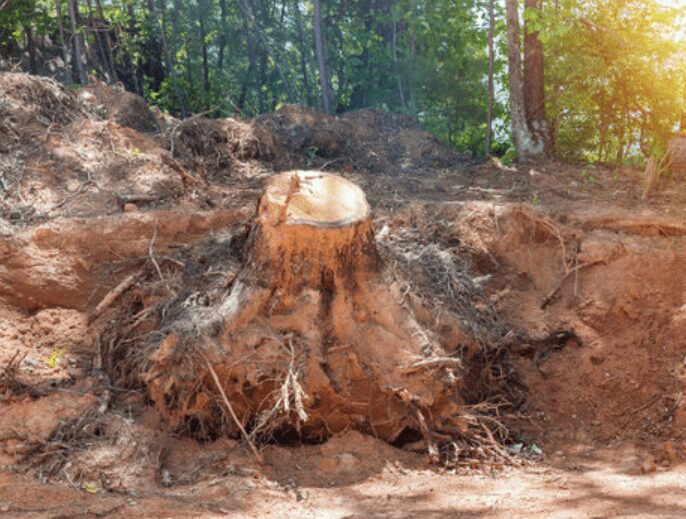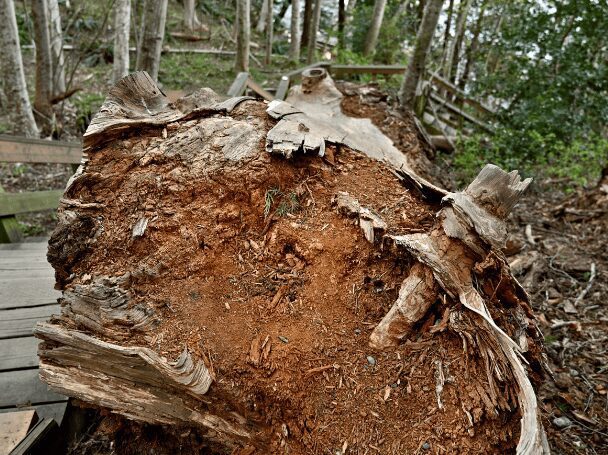
Removing tree Stumps can be easy if you have the proper machines; however, relying only on your hands might not seem easy. Tree stumps can be unsightly and pose a hazard in your yard.
Removing them without using a stump grinder can be challenging; however, following these precise steps can remove tree stumps without specialized equipment.
Chemical Stump Removal
Ingredients for Chemical Stump Removal
To effectively remove tree stumps using chemicals, you’ll need:
- A high-quality potassium nitrate (stump remover) granule
- A drill with a large, long drill bit
- A plastic tarp
- Water
- A chainsaw or handsaw
- Protective gloves and goggles
Step-by-Step Procedure
- Cut the stump: Use a chainsaw or handsaw to cut the stump as close to the ground as possible.
- Drill holes: Drill 1-inch diameter holes around the perimeter of the stump, 3-4 inches from the edge, and 8-12 inches deep. Space the holes about 3-4 inches apart.
- Apply potassium nitrate: Pour the potassium nitrate granules into each hole, filling them to the top.
- Add water: Pour water into each hole to dissolve the potassium nitrate.
- Cover the stump: Place the plastic tarp over the stump to retain moisture and accelerate the decomposition process.
- Monitor progress: Check the stump periodically. Within 4-6 weeks, the stump should become soft and spongy.
- Remove the stump: Once the stump is soft, use an ax or other tools to break it apart and remove the debris.
Manual Stump Removal
Tools Required for Manual Stump Removal
- A mattock or a pickaxe
- A digging bar
- A chainsaw or handsaw
- A shovel
- Protective gloves and goggles
Step-by-Step Procedure
- Dig around the stump: Use a mattock or pickaxe to dig around the stump and expose its roots.
- Sever the roots: Cut the exposed roots using a chainsaw or handsaw.
- Leverage the stump: Use a digging bar to pry the stump loose from the ground.
- Remove the stump: Once the stump is loose, remove it from the ground with the help of a shovel.
Burning the Stump

Materials Required for Burning the Stump
- A drill with a large, long drill bit
- Kerosene or fuel oil
- A match or lighter
- A chainsaw or handsaw
- Protective gloves and goggles
Step-by-Step Procedure
- Drill holes: Drill 1-inch diameter holes around the stump, 3-4 inches from the edge, and 8-12 inches deep. Space the holes about 3-4 inches apart.
- Pour kerosene or fuel oil: Fill each hole with kerosene or fuel oil to saturate the entire stump. Allow the liquid to soak into the stump for several hours or overnight.
- Ignite the stump: Use a match or lighter to ignite the kerosene or fuel oil in the stump. Be sure to stand back and observe the fire from a safe distance.
- Monitor the burn: Keep an eye on the burning stump, making sure it burns down to the ground. Depending on the stump’s size, this process may take several hours or even days.
- Extinguish the fire: After the stump has burned down completely, douse the remaining embers with water to ensure the fire is completely out.
- Remove the ash: Once the fire is extinguished and the area has cooled down, remove the ash and debris from the burned stump.
Decomposition Acceleration

Materials Required for Decomposition Acceleration
- High-nitrogen fertilizer
- A drill with a large, long drill bit
- A plastic tarp
- Water
- A chainsaw or handsaw
- Protective gloves and goggles
Step-by-Step Procedure
- Cut the stump: Use a chainsaw or handsaw to cut the stump as close to the ground as possible.
- Drill holes: Drill 1-inch diameter holes around the perimeter of the stump, 3-4 inches from the edge, and 8-12 inches deep. Space the holes about 3-4 inches apart.
- Apply high-nitrogen fertilizer: Fill each hole with a high-nitrogen fertilizer.
- Add water: Pour water into each hole to dissolve the fertilizer.
- Cover the stump: Place the plastic tarp over the stump to retain moisture and accelerate the decomposition process.
- Monitor progress: Check the stump periodically. Within a few months, the stump should become soft and spongy.
- Remove the stump: Once soft, use an ax or other tools to break it apart and remove the debris.
Frequently Asked Questions About Tree Stump Removal
- What is the fastest method for removing tree stumps without a stump grinder?
Burning the stump is typically the fastest method compared to manual removal, chemical removal, or decomposition acceleration. However, depending on the stump’s size, it may still take several hours or days.
- Is it safe to use chemicals for tree stump removal?
Yes, using chemicals like potassium nitrate is generally safe for stump removal. However, you should always follow the manufacturer’s instructions, wear protective gear, and keep children and pets away from the treated area.
- How long does it take for a tree stump to decompose naturally?
The time it takes for a tree stump to decompose naturally can vary greatly, depending on the size, species, and environmental conditions. It can take a few years to a decade or more for a stump to decompose completely.
- Do I need to remove tree stumps or leave them in the ground?
While it’s not always necessary to remove tree stumps, they can pose a safety hazard, attract insects, and negatively impact the aesthetics of your property. If any of these concerns are an issue, you should consider removing the stump.
- After removing a stump, can I plant a new tree in the same spot?
After removing a stump, you can plant a new tree in the same spot. However, you’ll need to remove as much of the old stump and root system as possible to provide the new tree with ample space for root growth.
- What can I do with the removed stump and debris?
You can repurpose the removed stump and debris into mulch or compost. Alternatively, you can dispose of it according to local waste management guidelines.
- Is burning a tree stump legal in all areas?
No, burning a tree stump may not be legal in all areas. You should always check with your local authorities and follow any guidelines or restrictions in place.
- What types of tree stumps are the hardest to remove?
Tree stumps from hardwood species, such as oak or maple, are generally harder to remove than those from softwood species, like pine or spruce. Additionally, older and larger stumps may be more challenging to remove due to their extensive root systems.
- Can I use salt to remove a tree stump?
While salt can be used to remove tree stumps, it’s generally not recommended as it can negatively impact the surrounding soil and vegetation. Using methods like chemical removal, manual removal, burning, or decomposition acceleration is better.
- Can I hire a professional to remove a tree stump without a grinder?
Yes, you can hire professionals to remove tree stumps using alternative methods to stump grinding. However, discussing your preferences with the service provider to ensure they can accommodate your request is essential.
Conclusion on Removing Tree Stumps
Removing a tree stump can be daunting, but we have explored several methods available to tackle even the most pesky stump. From using chemical stump remover products to manually digging out the roots with basic tools like a grub hoe, you can choose the most suitable approach based on factors like tree stump costs, size, and location.
For large tree stumps, you might prefer a more natural method, such as accelerating the rotting process with organic mulch and Epsom salt or a chemical method using stump removal chemicals.
Remember to wear steel-toed boots, follow safety precautions, and consult your local fire department if you decide to burn the stump.
Smaller roots can be dealt with using hand tools, while larger roots may require more manual labor or even heavy equipment. The decay process may take anywhere from a few weeks to several years, but with patience, proper equipment, and persistence, you’ll eventually rid your yard of the unsightly stump and its roots.
As you weigh your options, consider factors such as environmental impact, labor costs, and the time required for the job. Ultimately, the best way to remove a tree stump will depend on your unique circumstances, budget, and preferences.
As you explore the various methods for removing tree stumps, consider each option’s potential benefits and drawbacks. For instance, using a chemical stump remover product may be a practical solution, but it could have environmental implications.
On the other hand, opting for a more natural method, such as decomposing the stump with organic mulch, may be more eco-friendly but could require a longer time frame for the stump to decay completely.
Manual removal or burning the stump might be the preferred choice for those seeking faster results. However, manual labor can be physically demanding, and burning can pose safety risks if not done with caution. It’s essential to consult with your local fire department before starting any fires and adhere to any regulations or restrictions in your area.
When dealing with smaller roots, tools like loppers and root saws can be helpful, while larger roots may necessitate the use of more robust equipment or professional tree care services.
Always wear proper safety gear, such as steel-toed boots and protective eyewear, to minimize the risk of injury during removal.
Ultimately, the method you choose for removing a tree stump will depend on various factors, including your budget, the stump’s size, and the desired time frame for completion.
By carefully evaluating your options and taking necessary precautions, you can successfully remove tree stumps and improve the aesthetics and safety of your property.

























